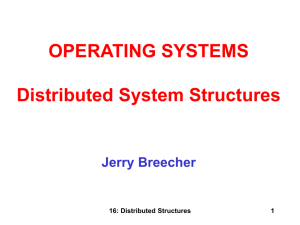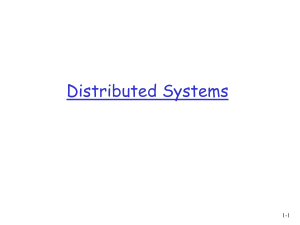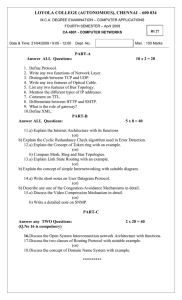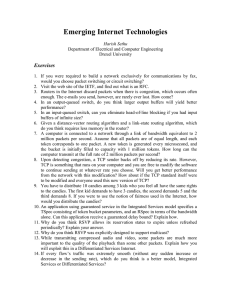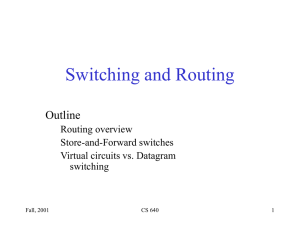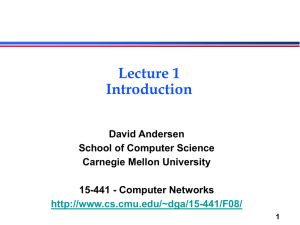Module 15: Network Structures Topology Network Types Communication
advertisement
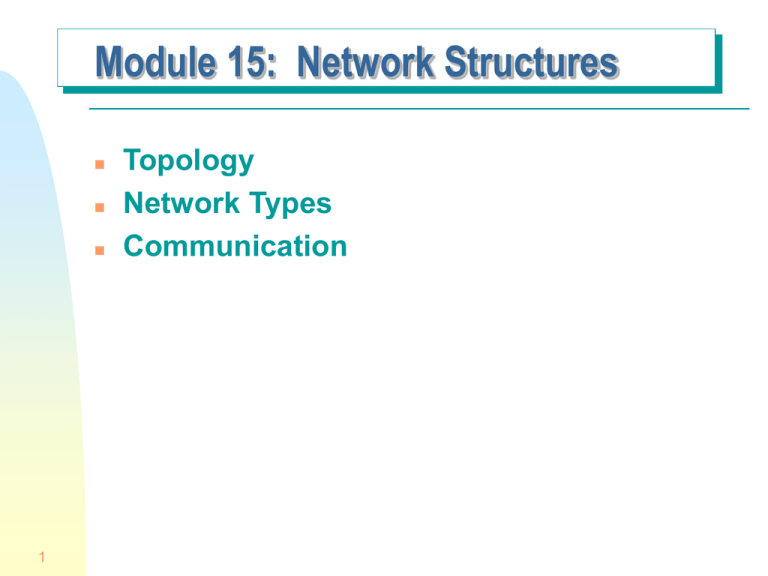
Module 15: Network Structures 1 Topology Network Types Communication Topology Sites in the system can be physically connected in a variety of ways Issues Basic cost. How expensive is it to link the various sites in the system? Communication cost. How long does it take to send a message from site A to site B? Reliability. If a link or a site in the system fails, can the remaining sites still communicate with each other? 2 The following six items depict various network topologies. • Fully connected network • Partially connected network 3 4 Tree-structured network Star network 5 Ring networks: (a) Single links. (b) Double links 6 Bus network: (a) Linear bus. (b) Ring bus. Network Types Local-Area Network (LAN) – designed to cover small geographical area. Multiaccess bus, ring, or star network. Speed 100-1000 megabits/second. Broadcast is fast and cheap. 7 Network Types (Cont.) Wide-Area Network (WAN) – links geographically separated sites. Point-to-point connections over long-haul lines (often leased from a phone company). Speeds of 1 Mbps to 100Mbps. Broadcast usually requires multiple messages. 8 Communication The design of a communication network must address four basic issues: 9 Naming and name resolution: How do two processes locate each other to communicate? Routing strategies. How are messages sent through the network? Connection strategies. How do two processes send a sequence of messages? Contention. The network is a shared resource, so how do we resolve conflicting demands for its use? Naming and Name Resolution Name systems in the network Address messages with the process-id. Identify processes on remote systems by <host-name, identifier> pair. 10 Domain name service (DNS) – specifies the naming structure of the hosts, as well as name to address resolution (Internet). Routing Strategies Fixed routing. A path from A to B is specified in advance; path changes only if hardware fails. Shortest path communication costs are minimized. Fixed routing cannot adapt to load changes. Fixed routing messages delivered in the order in which they were sent. Virtual circuit. A path from A to B is established and fixed for the duration of each session. Partial remedy to adapting to load changes. Also ensures that messages will be delivered in the order in which they were sent. 11 Routing Strategies (Cont.) Dynamic routing. The path used to send a message form site A to site B is chosen only when a message is sent. Usually a site sends a message to another site on the link least used at that particular time. Adapts to load changes by avoiding routing messages on heavily used path. Avoids failed hardware robustness and reliability Messages may arrive out of order. This problem can be typically solved by appending a sequence number to each message. 12 Connection Strategies Circuit switching. A permanent physical link is established for the duration of the communication (i.e., telephone system). Message switching. A temporary link is established for the duration of one message transfer (i.e., post-office mailing system). Packet switching. Messages of variable length are divided into fixed-length packets which are sent to the destination. Each packet may take a different path through the network. The packets must be reassembled into messages as they arrive. 13 Circuit switching requires setup time, but incurs less overhead for shipping each message, and may waste network bandwidth. Message and packet switching require less setup time, but incur more overhead per message. HARDWARE? Contention Several sites may want to transmit information over a link simultaneously. Techniques to avoid repeated collisions include: CSMA/CD. Carrier sense with multiple access (CSMA); collision detection (CD) A site determines whether another message is currently being transmitted over that link. If two or more sites begin transmitting at exactly the same time, then they will register a CD and will stop transmitting. When the system is very busy, many collisions may occur, and thus performance may be degraded. 14 SCMA/CD is used successfully in the Ethernet system, the most common network system. Contention (Cont.) 15 Token passing. A unique message type, known as a token, continuously circulates in the system (usually a ring structure). A site that wants to transmit information must wait until the token arrives. When the site completes its round of message passing, it retransmits the token. A token-passing scheme is used by the IBM and Apollo systems. Message slots. A number of fixed-length message slots continuously circulate in the system (usually a ring structure). Since a slot can contain only fixedsized messages, a single logical message may have to be broken down into a number of smaller packets, each of which is sent in a separate slot. This scheme has been adopted in the experimental Cambridge Digital Communication Ring ISO OSI Network Model 16 ISO OSI Network Model The communication network is partitioned into the following multiple layers; 17 Physical layer – handles the mechanical and electrical details of the physical transmission of a bit stream. Data-link layer – handles the frames, or fixedlength parts of packets, including any error detection and recovery that occurred in the physical layer. Network layer – provides connections and routes packets in the communication network, including handling the address of outgoing packets, decoding the address of incoming packets, and maintaining routing information for proper response to changing load levels. Design Strategies (Cont.) 18 Transport layer – responsible for low-level network access and for message transfer between clients, including partitioning messages into packets, maintaining packet order, controlling flow, and generating physical addresses. Session layer – implements sessions, or process-toprocess communications protocols. Presentation layer – resolves the differences in formats among the various sites in the network, including character conversions, and half duplex/full duplex (echoing). Application layer – interacts directly with the users, deals with file transfer, remote-login protocols and e-mail, as well as schemas for distributed databases. The ISO Network Message 19 Example including TCP/IP 20 An Ethernet Packet extra slide 21 The ISO Protocol Layer extra slide 22
